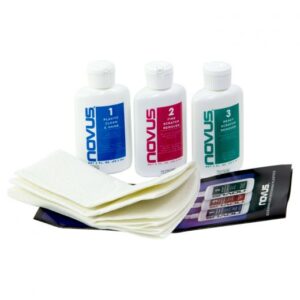Acrylic is a favored material throughout many industries for its incredible durability, high transparency, and ease of maintenance. An anti-glare, scratch-resistant alternative to glass, acrylic also proves to have a smaller environmental impact – it requires less energy to produce, weighs less during transportation and can be re-used more often. However, when trying to determine if acrylic is recyclable, the answer is a little more complicated.

Can Acrylic Be Recycled?
In short, yes, acrylic can be recycled. But there are many factors at play that convolute that response. The first thing to understand is there are several types of acrylic: Polymethyl methacrylate (PMMA), which is a rigid plastic used to make things like displays and signage, and Polymethyl acrylate (PMA), which is usually used to create liquids like paint or blended in with other materials to make textiles.
Which Types of Acrylic Can Be Recycled?
Since PMMA is a solid material, it has the capability of becoming recycled acrylic, unlike PMA which is far too difficult to separate from the other materials it’s mixed in with. Even so, the process for recycling PMMA is challenging, costly and potentially risky, which is why it’s marked as a ‘Group 7’ plastic and usually won’t get picked up curbside.
How Can Acrylic Be Recycled?
Pyrolysis is the difficult procedure in which PMMA is decomposed into a material that can be used to create recycled acrylic. It involves putting the acrylic in contact with molten lead to depolymerize it or change its chemical composition back to a monomer. Notably though, that technique has the potential to cause pollution and only a limited number of facilities have the equipment and expertise to successfully carry it out. It may still be worth researching vendors that accept acrylic for recycling, as it will prevent acrylic from ending up in landfills where it consequently could release harmful toxins as it resists biodegrading over time.
Tips for Taking Care of Acrylic to Make it Last
Another way to avoid the landfill is to elongate your use of acrylic material, which means making sure you’re maintaining it properly. When cleaning, use mild soap and water instead of abrasive solvents like ammonia or acetone, which can cause cracks and erode the surface. Commercial grade hexane or kerosene will take care of the more stubborn, set-in residue. Don’t expose it to any extreme temperatures or constant sunlight that could potentially cause reforming. Even if your acrylic starts to show some signs of wear and tear, there are ways to fix it. Use plastic polish and a microfiber cloth to buff out scratches, and for small cracks, a silicone sealant should do the trick.

Ways to Use Scrap Acrylic
There are also manufacturers who buy scrap acrylic and have produced innovative ways to re-use it. From optical lenses and car light covers to zoo enclosures and aquarium exhibits, there are plenty of useful items that can be made from this pre-used material. Artists also melt down recycled acrylic scraps to create beautiful sculptures, jewelry, and other objects. It can be cut up into abstract shapes or shredded using machines before being heated at extremely high temperatures to shape it.
Choose Recycled Acrylic
If sustainability is a top priority to you and your business, consider working with Acrylite® proTerra sheets from the recycled acrylic line of Acrylite® by Roehm. The sheet core is made up of 90% reused acrylic material sandwiched between thin outer layers of virgin PMMA to create a flawless surface. This type of recycled acrylic still boasts the same impressive qualities of unused sheets, like their crystal-clear clarity, durability, and resistance to weather and UV radiation. They’re stronger and lighter than glass, and easy to handle and process. Acme Plastics offers Acrylite® proTerra sheets at a variety of thicknesses, and custom options are available if you contact us directly.
Final Thoughts
While it’s no secret acrylic isn’t necessarily the most eco-friendly material, there are ways to prevent it from harming the environment. Taking diligent care of your acrylic products in order to extend their life and choosing recycled acrylic products for your displays and other projects are great ways to ensure reduced waste.

